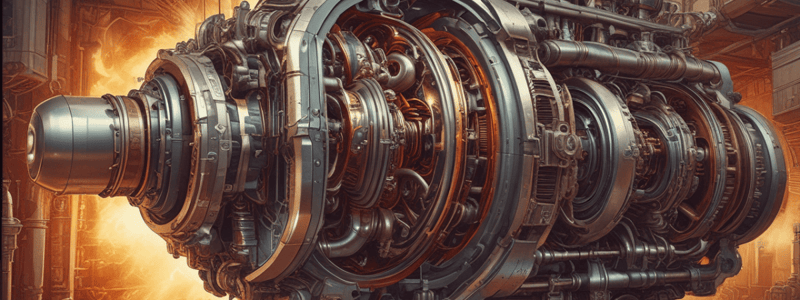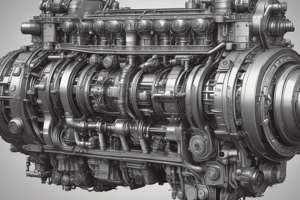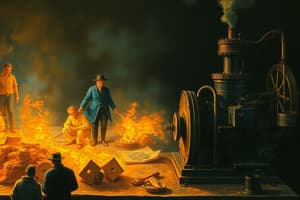Podcast
Questions and Answers
What is the main function of a heat engine?
What is the main function of a heat engine?
Which type of engine transfers heat to a second fluid that is the working fluid of the cycle?
Which type of engine transfers heat to a second fluid that is the working fluid of the cycle?
What type of engine has the combustion of air and fuels taking place inside the cylinder?
What type of engine has the combustion of air and fuels taking place inside the cylinder?
Which type of engines use a turbine for their basic design?
Which type of engines use a turbine for their basic design?
Signup and view all the answers
What distinguishes a four-stroke engine from a two-stroke engine?
What distinguishes a four-stroke engine from a two-stroke engine?
Signup and view all the answers
In which type of heat engine does the combustion of air and fuels take place directly in the cylinder?
In which type of heat engine does the combustion of air and fuels take place directly in the cylinder?
Signup and view all the answers
What type of engine has combustion of air-fuel inside the engine cylinder?
What type of engine has combustion of air-fuel inside the engine cylinder?
Signup and view all the answers
Which type of engine uses cheaper fuels including solid fuels?
Which type of engine uses cheaper fuels including solid fuels?
Signup and view all the answers
What is the function of piston rings in a reciprocating IC engine?
What is the function of piston rings in a reciprocating IC engine?
Signup and view all the answers
Which component of a reciprocating IC engine is responsible for transmitting the force exerted by the burning of the charge to the connecting rod?
Which component of a reciprocating IC engine is responsible for transmitting the force exerted by the burning of the charge to the connecting rod?
Signup and view all the answers
What is the main purpose of a cylinder head in an IC engine?
What is the main purpose of a cylinder head in an IC engine?
Signup and view all the answers
In which type of engine is a boiler used for combustion of air-fuel?
In which type of engine is a boiler used for combustion of air-fuel?
Signup and view all the answers
Which type of ring on the piston provides an effective seal to prevent oil leakage into the engine cylinder?
Which type of ring on the piston provides an effective seal to prevent oil leakage into the engine cylinder?
Signup and view all the answers
What is the main function of connecting rod in a reciprocating IC engine?
What is the main function of connecting rod in a reciprocating IC engine?
Signup and view all the answers
What is the significance of using special alloys in internal combustion engines?
What is the significance of using special alloys in internal combustion engines?
Signup and view all the answers
What feature distinguishes between single-cylinder and multi-cylinder engines?
What feature distinguishes between single-cylinder and multi-cylinder engines?
Signup and view all the answers
What is the reverse process to combustion?
What is the reverse process to combustion?
Signup and view all the answers
At what temperature does the dissociation of CO2 into CO and O2 start commencing?
At what temperature does the dissociation of CO2 into CO and O2 start commencing?
Signup and view all the answers
Which gases tend to prevent the dissociation of CO2?
Which gases tend to prevent the dissociation of CO2?
Signup and view all the answers
In internal combustion engines, what causes a reduction in the maximum temperature and pressure?
In internal combustion engines, what causes a reduction in the maximum temperature and pressure?
Signup and view all the answers
What reduces the maximum temperature by about 300°C even at the chemically correct air-fuel ratio?
What reduces the maximum temperature by about 300°C even at the chemically correct air-fuel ratio?
Signup and view all the answers
What is the effect of dissociation on output power in a spark-ignition engine?
What is the effect of dissociation on output power in a spark-ignition engine?
Signup and view all the answers
What process can be looked at as the disintegration of combustion products at high temperature?
What process can be looked at as the disintegration of combustion products at high temperature?
Signup and view all the answers
What is the function of the crankshaft in an internal combustion engine?
What is the function of the crankshaft in an internal combustion engine?
Signup and view all the answers
Which alloy is commonly used for manufacturing the connecting rod in an internal combustion engine?
Which alloy is commonly used for manufacturing the connecting rod in an internal combustion engine?
Signup and view all the answers
What is the Dead Centre in an internal combustion engine?
What is the Dead Centre in an internal combustion engine?
Signup and view all the answers
What is the main function of a flywheel in an internal combustion engine?
What is the main function of a flywheel in an internal combustion engine?
Signup and view all the answers
In a four-stroke engine, what happens during the suction stroke?
In a four-stroke engine, what happens during the suction stroke?
Signup and view all the answers
Which engine has a heavier flywheel due to non-uniform turning movement?
Which engine has a heavier flywheel due to non-uniform turning movement?
Signup and view all the answers
What is the role of the clearance volume in an internal combustion engine?
What is the role of the clearance volume in an internal combustion engine?
Signup and view all the answers
Which term refers to the nominal volume generated by the working piston between two dead centres?
Which term refers to the nominal volume generated by the working piston between two dead centres?
Signup and view all the answers
'Volumetric efficiency' in an internal combustion engine relates to what aspect of its operation?
'Volumetric efficiency' in an internal combustion engine relates to what aspect of its operation?
Signup and view all the answers
'Compression ratio' in an internal combustion engine is defined as what?
'Compression ratio' in an internal combustion engine is defined as what?
Signup and view all the answers
What is the expansion ratio or pressure ratio in an Otto cycle?
What is the expansion ratio or pressure ratio in an Otto cycle?
Signup and view all the answers
During which process in the Otto cycle is heat rejected to an external sink?
During which process in the Otto cycle is heat rejected to an external sink?
Signup and view all the answers
What is the characteristic gas constant R in relation to specific heats?
What is the characteristic gas constant R in relation to specific heats?
Signup and view all the answers
At what temperature range do gases generally show an increase in specific heat?
At what temperature range do gases generally show an increase in specific heat?
Signup and view all the answers
What is the relationship between temperature T2 and T1 during adiabatic compression in an Otto cycle?
What is the relationship between temperature T2 and T1 during adiabatic compression in an Otto cycle?
Signup and view all the answers
Which equation represents the increase in specific heat for gases at higher temperatures?
Which equation represents the increase in specific heat for gases at higher temperatures?
Signup and view all the answers
What happens to the final temperature and pressure if variable specific heats are considered during the compression stroke in an Otto cycle?
What happens to the final temperature and pressure if variable specific heats are considered during the compression stroke in an Otto cycle?
Signup and view all the answers
What does the difference between Cp and Cv depend on for gases?
What does the difference between Cp and Cv depend on for gases?
Signup and view all the answers
What is the value of specific heat for air at 300 K?
What is the value of specific heat for air at 300 K?
Signup and view all the answers
What is the work done formula in an Otto cycle?
What is the work done formula in an Otto cycle?
Signup and view all the answers
What is a characteristic of a two-stroke engine?
What is a characteristic of a two-stroke engine?
Signup and view all the answers
Why is the flywheel lighter in a two-stroke engine?
Why is the flywheel lighter in a two-stroke engine?
Signup and view all the answers
What is a downside of a two-stroke engine?
What is a downside of a two-stroke engine?
Signup and view all the answers
Which type of engine uses the Otto cycle?
Which type of engine uses the Otto cycle?
Signup and view all the answers
What is a characteristic of a diesel engine?
What is a characteristic of a diesel engine?
Signup and view all the answers
What type of heat addition does the Otto cycle operate with?
What type of heat addition does the Otto cycle operate with?
Signup and view all the answers
What assumption is made about the gas in the cylinder for air-standard cycles?
What assumption is made about the gas in the cylinder for air-standard cycles?
Signup and view all the answers
Why is the air-cycle approximation used despite not closely representing actual cylinder conditions?
Why is the air-cycle approximation used despite not closely representing actual cylinder conditions?
Signup and view all the answers
What defines the simplest theoretical cycle used for calculating conditions in internal combustion engines?
What defines the simplest theoretical cycle used for calculating conditions in internal combustion engines?
Signup and view all the answers
What happens to the maximum temperature as the air-fuel ratio decreases in an internal combustion engine?
What happens to the maximum temperature as the air-fuel ratio decreases in an internal combustion engine?
Signup and view all the answers
Why are dissociation effects less pronounced in a CI engine compared to an SI engine?
Why are dissociation effects less pronounced in a CI engine compared to an SI engine?
Signup and view all the answers
How does dissociation affect the pressure in the expansion stroke of an internal combustion engine?
How does dissociation affect the pressure in the expansion stroke of an internal combustion engine?
Signup and view all the answers
Which type of loss occurs when combustion gases leak past the piston rings into the crankcase?
Which type of loss occurs when combustion gases leak past the piston rings into the crankcase?
Signup and view all the answers
What is the main cause of incomplete combustion in an internal combustion engine?
What is the main cause of incomplete combustion in an internal combustion engine?
Signup and view all the answers
How do exhaust heat losses affect the overall efficiency of an internal combustion engine?
How do exhaust heat losses affect the overall efficiency of an internal combustion engine?
Signup and view all the answers
Which process in the Otto Cycle corresponds to spark-ignition and combustion in an actual engine?
Which process in the Otto Cycle corresponds to spark-ignition and combustion in an actual engine?
Signup and view all the answers
Why do engine designers work to minimize friction losses between moving engine components?
Why do engine designers work to minimize friction losses between moving engine components?
Signup and view all the answers
What effect does a rich mixture have on dissociation effects in an internal combustion engine?
What effect does a rich mixture have on dissociation effects in an internal combustion engine?
Signup and view all the answers
What is the primary reason for lower peak gas temperatures in a compression-ignition (CI) engine compared to a spark-ignition (SI) engine?
What is the primary reason for lower peak gas temperatures in a compression-ignition (CI) engine compared to a spark-ignition (SI) engine?
Signup and view all the answers
What is the expression for the thermal efficiency of an Otto cycle?
What is the expression for the thermal efficiency of an Otto cycle?
Signup and view all the answers
What is the impact of increasing the compression ratio on the thermal efficiency of an Otto cycle?
What is the impact of increasing the compression ratio on the thermal efficiency of an Otto cycle?
Signup and view all the answers
What does the thermal efficiency of an Otto cycle depend on?
What does the thermal efficiency of an Otto cycle depend on?
Signup and view all the answers
In the Otto cycle, what is the relationship between temperatures T1, T2, T3, and T4?
In the Otto cycle, what is the relationship between temperatures T1, T2, T3, and T4?
Signup and view all the answers
What factor contributes to increasing the efficiency of an Otto cycle?
What factor contributes to increasing the efficiency of an Otto cycle?
Signup and view all the answers
How is the net work output for an Otto cycle represented?
How is the net work output for an Otto cycle represented?
Signup and view all the answers





